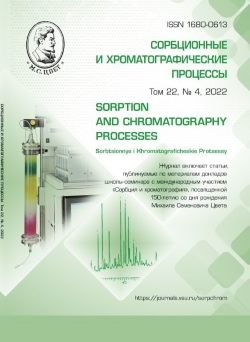The effect of the concentration of ion-exchange resin on the electrotransport properties of heterogeneous membranes
Abstract
The purpose of our study was to investigate the effect of the concentration of ion-exchange resin in heterogeneous membranes on their electrical conductivity and to assess the selectivity of the membranes based on the analysis of transport and structural parameters of an extended three-wire conductivity model.
The article focuses on the conductivity of a range of experimental cation and anion exchange membranes with various concentrations of ion-exchange resin. The membranes were produced based on a functionalised polystyrene ion-exchange resin, an inert polyethylene binder, and a reinforcing polyester grid. The fixed groups in cation exchange membranes were sulphonic acid bases and in anion exchange membranes - quaternary ammonium bases. Physico-chemical properties of the studied samples of membranes were determined using standard testing methods for ion exchange membranes. The specific conductivity of the membranes was determined based on their resistivity measured using a mercury probe. The concentration dependences of the specific electrical conductivity of the membranes in sodium chloride solutions were used to calculate the transport, structural, and geometric parameters of the extended three-wire conductivity model.
The study determined that the ratio of the ion exchanger and the inert binder has a decisive influence on the current flow in the membrane and its selectivity. It was also determined that the electrical conductivity of the membranes increases with an increase of the concentration of the solution and the concentration of ion-exchange resin in the membranes. The analysis of the transport and structural parameters revealed dependences between the concentration of the ion exchanger and the structure of the membranes. The dependence of model parameters on the concentration of the resin in cation exchange membranes is stepwise is stepwise in the region of the mass fraction of the ion exchanger of 55%. The analysis of the changes in the structural parameters demonstrated that there is free solution both in the pores and the defects of the structure, as well as in the particles of ion-exchange resin. The selectivity of anion exchange membranes in the studied range of concentrations of the resin remains practically the same.
An increase in the portion of the ion exchanger results in an increase in the portion of the free solution which is distributed in the particles of the ion-exchange resin. However, it does not have any significant effect on the selectivity of the samples. The actual transport number of counterions in ion exchange membranes calculated based on the model parameters also increases with an increase in the portion of the ion exchanger.
Downloads
References
Vasil’eva V., Goleva E., Pismenskaya N., Kozmai A., Nikonenko V. Effect of surface profiling of a cation-exchange membrane on the phenylalanine and NaCl separation performances in diffusion dialysis. Sep. Purif. Technol. 2019; 210; 48-59. https://doi.org/10.1016/j.seppur.2018.07.065
Kozaderova O.A., Kim K.B., Gadzhiyevа Ch.S., Niftaliev S.I. Electrochemical characteristics of thin heterogeneous ion exchange membrane. J. Membr. Sci. 2020; 604: Art. No. 118081. https://doi.org/10.1016/j.memsci.2020.118081
Nebavskaya K.A., Butylskii D.Yu., Moroz I.A., Nebavsky A.V., Pismenskaya N.D., Nikonenko V.V., Enhancement of mass transfer through a homogeneous anion-exchange membrane in limiting and overlimiting current regimes by screening part of its surface with nonconductive strips. Petroleum Chemistry. 2018; 58: 780-789. https://doi.org/10.1134/S0965544118090086
Vyas P.V., Shah B.G., Trivedi G.S., Ray P., Adhikary S.K., Rangarajan R., Characterization of heterogeneous anion-exchange membrane. J. Membr. Sci. 2001; 187: 39-46. https://doi.org/10.1016/S0376-7388(00)00613-X
Vyas P.V., Ray P., Adhikary S.K., Shah B.G., Rangarajan R., Studies of the effect of variation of blend ratio on perm-selectivity and heterogeneity of ion-exchange membranes. J. Colloid Interface Sci. 2003; 257; 127-134. https://doi.org/10.1016/S0021-9797(02)00025-5
Khodabakhshi A.R., Madaeni S.S., Hosseini S.M. Comparative studies on morphological, electrochemical, and mechanical properties of s-polyvinyl chloride based heterogeneous cation-exchange membranes with different resin ratio load-ing. Ind. Eng. Chem. Res. 2010; 49: 8477-8487. https://doi.org/10.1021/ie9014205
Hale D.K., McCauley D.J. Structure and properties of heterogeneous cation-exchange membranes. Transactions of the Faraday Society. 1961; 57: 135-149. https://doi.org/10.1039/TF9615700135
Vasil’eva V.I., Saud A.M., Akberova E.M. Separation of phenylalanine aqueous salt solutionsby electrodialysis using membranes with different mass fractions of sulfonated cation-exchange resin. Sorbtsionnye I khromatograficheskie protsessy. 2021; 21; 498-509. https://doi.org/10.17308/sorpchrom.2021.21/3634 (In Russ.)
Falina I.V., Demina O.A., Kononenko N.A., Annikova L.A. Influence of inert components on the formation of conducting channels in ion-exchange membranes. J. Solid State Electrochem. 2017; 21: 767-775. https://doi.org/10.1007/s10008-016-3415-0
Oren Y., Freger V., Linder C. Highly conductive ordered heterogeneous ion-exchange membranes. J. Membr. Sci. 2004; 239: 17-26. https://doi.org/10.1016/j.memsci.2003.12.031
Berezina N.P., Kononenko N.A., Dyomina O.A., Gnusin N.P. Characterization of ion-exchange membrane materials: properties vs structure. Adv. Colloid Inter-face Sci. 2008; 139: 3-28. https://doi.org/10.1016/j.cis.2008.01.002
Gnusin N.P., Zabolockij V.I., Nikonenko V.V., Meshechkov A.I., Razvitie principa obobshhennoj provodimosti k opisaniju javlenij perenosa v dispersnyh sistemah. Zhurn. fiz. Himii. 1980; 65(6): 1518-1522. (In Russ.)
Demina O.A., Kononenko N.A., Falina I.V. New approach to the characterization of ion-exchange membranes using a set of model parameters. Petroleum Chemistry. 2014; 54: 515-525. https://doi.org/10.1134/S0965544114070032
Demina O.A., Falina I.V. Svidetel'stvo o gosudarstvennoj registracii programmy dlja JeVM. No 2014662877, 2014.







